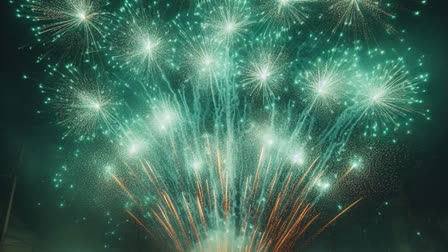New Delhi:The Delhi sky lit up on Thursday as people celebrated Diwali defying a ban on firecrackers. Areas including Lajpat Nagar, Kalkaji, Chhatarpur, Jaunapur, East of Kailash, Saket, Rohini, Dwarka, Punjabi Bagh, Vikas Puri, Dilshad Garden, Burari and many other neighbourhoods of east and west Delhi saw firecrackers being burst.
At 9 pm, Delhi's Air Quality Index (AQI) was recorded at 327, with Alipur, Anand Vihar, Ashok Vihar, Aaya Nagar, Bawana, Burari, Mathura Road, IGI Airport, Dwarka, Jahangirpuri, Mundka, Narela, Patparganj, Rohini, Shadipur, Sonia Vihar, Wazirpur, Mandir Marg, Nehru Nagar, Najafgarh and other weather-monitoring stations witnessing "very poor" air quality, according to the Sameer app that provides hourly updates of the National AQI published by the Central Pollution Control Board (CPCB).
With the 24-hour AQI recorded at 328 at 4 pm, Delhi experienced its worst air quality on Diwali in the last three years. Following the practice of the last four years, the city government announced a comprehensive ban on the manufacture, storage, sale and use of firecrackers earlier this month.
Delhiites woke up to a sky shrouded in a thick layer of smog on Diwali morning as the air quality continued to deteriorate, remaining in the "very poor" category with a recorded AQI of 328 at 4 pm. Last year, the citizens of the capital enjoyed a clearer sky and abundant sunshine on Diwali, with an AQI of 218, compared to 312 in 2022, 382 in 2021, 414 in 2020, 337 in 2019, 281 in 2018, 319 in 2017 and 431 in 2016, according to the CPCB.
Last year, a decrease in stubble-burning incidents and rain before Diwali, along with favourable meteorological conditions, prevented the capital from turning into a gas chamber after the festival. The pollutant PM2.5 level was recorded at 144 micrograms per cubic metre at 8 pm. The PM10 level was 273 micrograms per cubic metre, according to the CPCB's data.
